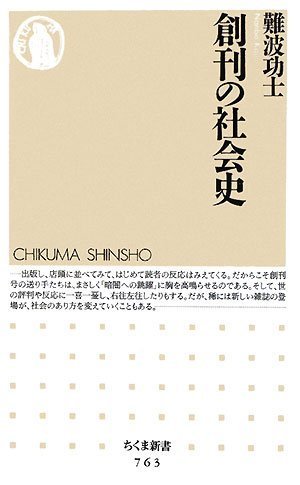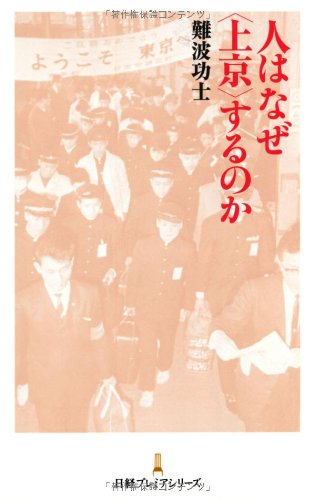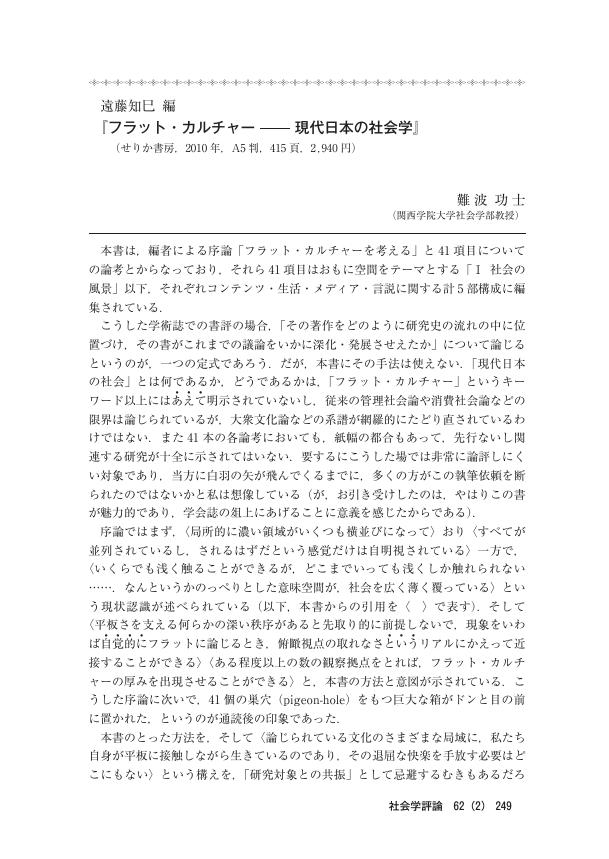2 0 0 0 IR "-er"の系譜 : サブカルチェラル・アイデンティティの現在
- 著者
- 難波 功士
- 出版者
- 関西学院大学
- 雑誌
- 関西学院大学社会学部紀要 (ISSN:04529456)
- 巻号頁・発行日
- vol.100, pp.181-189, 2006-03-15
In the 1970s, some young people began to take pleasure in creating Japanese words coined with the suffix '-er'. For example, there were readers and contributors of "Bikkurihouse" magazine, who were called "(Bikkuri-) houser", first by editors, and then even by themselves. In this era, coinages with '-er' were alternatives for labeling the youth by adults or the mass media. In the 1980s, such puns and word-plays were diffused among young people. In the middle of the 1990s, the new words, 'Chaneller' and 'Amuror', were used by young people and immediately became vogue-words through the mass media. The former meant fans of 'Chanel' brand and the latter meant wannabes of 'Amuro Namie', who was the singer and dancer most popular with teenage girls at that time. Afterwards, many new coinages have been made by this word formation, 'brand name +er' or 'celebrity's name +er'. In the end, the genealogy of Japanese coinages with the suffix '-er' resulted in the emergence of fandom following certain brands or modes advocated by celebrities through the mass media.
1 0 0 0 族の系譜学 : ユース・サブカルチャーズの戦後史
1 0 0 0 OA <研究ノート>デッドヘッズ・ネットワーク
- 著者
- 難波 功士 Koji Namba
- 雑誌
- 関西学院大学社会学部紀要 (ISSN:04529456)
- 巻号頁・発行日
- no.86, pp.185-192, 2000-03-21
- 著者
- 難波 功士 Koji Nanba
- 雑誌
- 関西学院大学社会学部紀要 (ISSN:04529456)
- 巻号頁・発行日
- no.88, pp.33-45, 2000-10-20
1 0 0 0 OA なぜ「メディア文化研究」なのか(<特集>メディア文化研究の課題と展望)
- 著者
- 難波 功士
- 出版者
- 日本マス・コミュニケーション学会
- 雑誌
- マス・コミュニケーション研究 (ISSN:13411306)
- 巻号頁・発行日
- vol.78, pp.19-33, 2011-01-31 (Released:2017-10-06)
- 参考文献数
- 15
In this paper I insist the increasing value of adopting media cultural studies, after I defined the media culture as peoples' ways of life surrounding by media based on the relative decline of situation of mass communication recently. And then as well as media cultural studies will refer to the recent condition of media actually, based on much wider perspective, I unfold the consideration about the essence of media and I also offer an opinion that they progresses by becoming both wheels.
1 0 0 0 二人のコーエン
- 著者
- 難波 功士
- 出版者
- 社会学研究会
- 雑誌
- ソシオロジ (ISSN:05841380)
- 巻号頁・発行日
- vol.64, no.1, pp.128-130, 2019-06
1 0 0 0 OA ユース・サブカルチャー研究における状況的パースペクティブ : 戦後日本社会を題材として
- 著者
- 難波 功士 Koji Namba
- 雑誌
- 関西学院大学社会学部紀要 (ISSN:04529456)
- 巻号頁・発行日
- no.95, pp.107-121, 2003-10-28
1 0 0 0 OA 「J ターン」試論 : 日本におけるユース・サブカルチャーズの受容と変容
- 著者
- 難波 功士 Koji Namba
- 雑誌
- 関西学院大学社会学部紀要 (ISSN:04529456)
- 巻号頁・発行日
- no.106, pp.101-108, 2008-10-30
1 0 0 0 OA 戦後ユース・サブカルチャーズをめぐって(3) : 暴走族とクリスタル族
- 著者
- 難波 功士
- 出版者
- 関西学院大学
- 雑誌
- 関西学院大学社会学部紀要 (ISSN:04529456)
- 巻号頁・発行日
- vol.98, pp.43-67, 2005-03-15
Since 1959, in the year 'Kaminari-zoku (Thunder Tribe)' was born, some Japanese motorcycle gangs began to be criticized and controlled by the police, educational institutions, and the press, which called them by names such as 'Mach-zoku', 'Harajuku-zoku' and 'Circuit-zoku'. Among them, the 'Boso-zoku (Joy-ride Tribe)', who appeared in the middle of the 1970s as the result of motorization and economic growth, provoked the most significant 'moral panic', and it was depicted as the most sensational 'folk devil' in Japanese society. Almost all of the members were males in their upper teens. They were high school students or manual workers. Their social class background was not so low, compared with other delinquent boys, though one of their features was their hostility toward the ethos of the middle class. They rejected higher learning or were rejected by it. Other features of the 'Boso-zoku' were masculinity, a sense of territory, kitsch-like nationalism, or aspiration to be featured by media, such as newspapers, car magazines and photo-books. By many means of regulation, in the 1980s, the number of 'Boso-zoku' groups and their size decreased. However, 'Yankees', 'Boso-zoku' sympathizers or alumni, have maintained or developed a unique life style. Even now, the word 'zoku' has become a synonym for 'Boso-zoku', and 'Yankee culture' survives. While 'Yankee culture' has been constructed as Japanese working class youth culture, since the 1970s, against the background of rapid growth of the college-attendance ratio from the 1960s to the 1970s, college students from middle class families constructed their own youth subculture in the beginning of the 1980s, influenced by some 'catalogue magazines' featuring trendy fashions or shops. They were named the 'Crystal-zoku' after a novel, 'Nanto-naku, Crystal (Being Like a Crystal without Reason)' written by Yasuo Tanaka. In this novel, Tanaka depicted the urban lifestyle of a female student who belonged to tennis circle, had a part-time job as a fashion model, lived with a boyfriend in a fashionable area, dressed in expensive clothes and accessories with stylish brand names, and sometimes went to a disco to meet another boyfriend. Being the opposite to 'Boso-zoku', 'Crystal-zoku' was female-centered. They loved to go shopping and to spend much time in leisure around Minato-ku or Shibuya-ku, while 'Boso-zoku' or 'Yankees' committed themselves to the locality where they lived. In the 1980s, every young person became interested in consumption, especially in fashion. So, many cliques focusing on different tastes for fashion emerged. There was the most significant division between college-goers (white-collar worker candidates) and non-college-goers (salesclerk or blue-collar candidates). In this paper, I examine 'Crystal-zoku' as an extreme example of the former and 'Yankees' of the latter. However, despite the difference of their backgrounds, these two youth subcultures symbolized the beginning of the period in which everybody's identity was based on how much money was spent on consumption, or how to consume.
- 著者
- 難波 功士
- 出版者
- コーケン出版
- 雑誌
- 月刊民放 (ISSN:03873811)
- 巻号頁・発行日
- vol.43, no.6, pp.28-31, 2013-06
1 0 0 0 人はなぜ「上京」するのか
1 0 0 0 OA 遠藤知巳編『フラット・カルチャー――現代日本の社会学』
- 著者
- 難波 功士
- 出版者
- 日本社会学会
- 雑誌
- 社会学評論 (ISSN:00215414)
- 巻号頁・発行日
- vol.62, no.2, pp.249-250, 2011-09-30 (Released:2013-11-19)
1 0 0 0 戦後日本におけるメディアと若者に変容に関する社会史的研究
平成15年度に発表した「戦後ユース・サブカルチャーについて(1):太陽族からみゆき族へ」(『関西学院大学社会学部紀要』96)に引き続き、本研究期間中に「戦後ユース・サブカルチャーをめぐって(5):コギャルと裏原系」(『関西学院大学社会学部紀要』100)までの計5本のシリーズ論文と、それに関連する研究ノート計4本を紀要に発表した。これらに平成15年度に発表した「ユース・サブカルチャー研究における状況的パースペクティブ」(『関西学院大学社会学部紀要』95)や「ユース・サブカルチャーズの国際比較のために」(文部科学省21世紀COEプログラム研究報告書r国際比較研究のフロンティア』)の内容を加味し、今回別添報告書をまとめている。本研究は、日本におけるユース・サブカルチャーズ研究進展のための用語体系(タロミノロジー)、や方法論(メソドロジー)の検討・整備とともに、史資料の集積とそれにもとづく具体的な分析を目ざしたものであった。一応の理論的検討と通史的な記述を終えたので、今後は、今回提出した報告書の内容を一書にまとめ、公刊する作業の中で、理論と分析との統合をはかり、この2年間で得た知見である「70年代後半に若者文化のみならず、日本社会の大きな画期があった」との主張を、より説得的に提示していきたい。またこの2年間の成果は、国際日本文化研究センター共同研究員として参加した「コマーシャル映像にみる物質文化と情報文化」(代表山田奨治氏、平成15〜17年度)、研究分担者として参加した科学研究費補助金(基盤研究(C))「テレビ文化のメディア史的考察」(研究代表者・長谷正人氏、平成16〜17年度)などの研究成果を公刊していく作業や、現在研究分担者として参加している科学研究費補助金(基盤研究(C))「地方博覧会の文化史的研究」(研究代表者・柴田哲雄氏、平成17〜19年度)などの共同研究に反映させていきたい。
1 0 0 0 OA なぜ「メディア文化研究」なのか(<特集>メディア文化研究の課題と展望)
- 著者
- 難波 功士
- 出版者
- 日本マス・コミュニケーション学会
- 雑誌
- マス・コミュニケーション研究 (ISSN:13411306)
- 巻号頁・発行日
- no.78, pp.19-33, 2011-01-31
In this paper I insist the increasing value of adopting media cultural studies, after I defined the media culture as peoples' ways of life surrounding by media based on the relative decline of situation of mass communication recently. And then as well as media cultural studies will refer to the recent condition of media actually, based on much wider perspective, I unfold the consideration about the essence of media and I also offer an opinion that they progresses by becoming both wheels.
- 著者
- 難波 功士
- 出版者
- 関西学院大学
- 雑誌
- 関西学院大学社会学部紀要 (ISSN:04529456)
- 巻号頁・発行日
- vol.88, pp.33-45, 2000-10
- 被引用文献数
- 1




